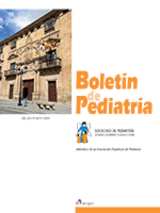Zurdos y diestros: etiopatogenia y salud
A. Muñoz Lozón Ana , M.D. Revilla Orías , P. Domínguez Sánchez , S. Gautreaux Minaya , M. Fernández Miaja , L.M. Rodríguez Fernández
Bol. Pediatr. 2014; 54 (227): 14 - 19
Introducción. El origen de la lateralidad y su influencia en la presencia de patología ha sido estudiado por diversos autores sin haberse obtenido ninguna conclusión definitiva al respecto. Los objetivos de la presente revisión son examinar la prevalencia de la lateralidad, estudiar su etiología y condicionantes, y profundizar en la relación entre la lateralidad y la salud. Desarrollo. Existen diversas teorías sobre el origen de la lateralidad. La mayoría de los autores aceptan que existe un componente genético, pero se desconocen los mecanismos de herencia y el gen o los genes implicados. Por otro lado, parece ser que ciertos niveles hormonales intraútero, como los de testosterona, melatonina o vitamina D, podrían jugar un papel en el desarrollo de una lateralidad no diestra. Otros eventos prenatales, como las infecciones o la hipoxia, también parecen influir en la especialización hemisférica. Además, existe una fuerte influencia ambiental en la preferencia manual. Ya sea como una causa o como una consecuencia, se ha relacionaldo la lateralidad con determinadas patologías y eventos adversos, como enfermedades autoinmunes, psiquiátricas y perinatales. Conclusiones. Aunque existen diversos estudios sobre el origen, la etiopatogenia y las implicaciones sobre la salud de una lateralidad no diestra, son muchas las incógnitas que quedan por resolver. Sin embargo, hay evidencias para pensar que los individuos zurdos podrían ser más propensos a padecer ciertas patologías. Un mayor estudio en este campo podría proporcionarnos un conocimiento más amplio sobre el funcionamiento del sistema nervioso central y su influencia sobre determinadas enfermedades.
Left handed and right handed persons: etiopathogeny and health
Introduction. The origin of the laterality and its influence in the presence of pathology has been studied by various authors without having obtained any definitive conclusion on the matter. The objectives of this review are to examine the prevalence of laterality, study its etiology and constraints, and deepen the relationship between the laterality and health.
Development. There are various theories about the origin of laterality. The majority of the authors agree that there is a genetic component, but it is unknown the mechanisms of inheritance, and the gene or genes involved. On the other hand, seems to be that certain intrauterine hormonal levels, such as testosterone, melatonin, or vitamin D may play a role in the development of a laterality not skillful. Other prenatal events, such as infections or hypoxia, also appear to influence the hemispheric specialization. In addition there is a strong environmental infl uence on the preference manual. Either as a cause or as a result, it has been related the laterality with certain pathologies and adverse events, such s etiology and constraints, and deepen the relationship between the laterality and health.
Conclusions. Although there are various studies on the origin, the pathogenesis and the implications for the health of a laterality does not right hand, there are many questions that remain to be resolved. However, there is evidence to believe that the left-handed individuals might be more prone to certain diseases. A further study in this fi eld could provide a more comprehensive knowledge on the functioning of the central nervous system and its infl uence on certain diseases
Artículo completo (PDF) (257 kb.)
- Neurología
